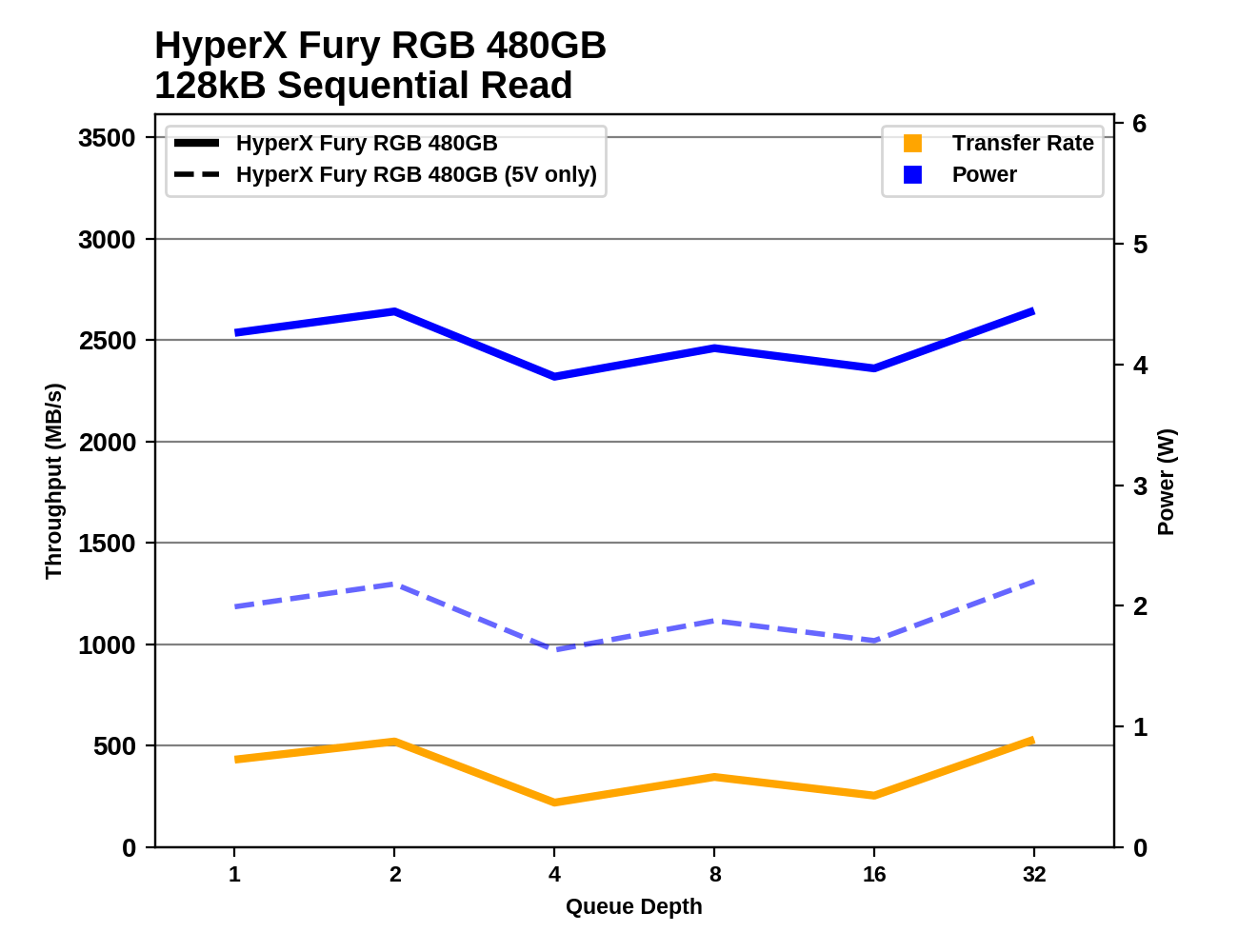The Kingston HyperX Fury RGB SSD Review: Bright Idea, Dimmed Performance
by Billy Tallis on September 24, 2018 8:35 AM ESTSequential Read Performance
Our first test of sequential read performance uses short bursts of 128MB, issued as 128kB operations with no queuing. The test averages performance across eight bursts for a total of 1GB of data transferred from a drive containing 16GB of data. Between each burst the drive is given enough idle time to keep the overall duty cycle at 20%.

The QD1 burst sequential read performance of the HyperX Fury RGB is relatively slow for a SATA SSD, but it's less than a 10% difference relative to the fastest SATA drives in this batch.
Our test of sustained sequential reads uses queue depths from 1 to 32, with the performance and power scores computed as the average of QD1, QD2 and QD4. Each queue depth is tested for up to one minute or 32GB transferred, from a drive containing 64GB of data. This test is run twice: once with the drive prepared by sequentially writing the test data, and again after the random write test has mixed things up, causing fragmentation inside the SSD that isn't visible to the OS. These two scores represent the two extremes of how the drive would perform under real-world usage, where wear leveling and modifications to some existing data will create some internal fragmentation that degrades performance, but usually not to the extent shown here.

On the longer sequential read test the Fury RGB again comes in last place with substantially slower read speeds for contiguous data than any other drive in this batch, but it does handle internal fragmentation reasonably well.
 |
|||||||||
| Power Efficiency in MB/s/W | Average Power in W | ||||||||
Not counting the power used for the LED lighting, the Fury RGB uses a fairly normal ~2W for the sequential read test but it doesn't score very well on the efficiency rating because of the poor performance.
 |
|||||||||
Performance on the sequential read test is unusually variable for the HyperX Fury RGB. Given that it is averaging over 4W for most of this test, I suspect we're seeing thermal throttling. SSDs without LED lighting idle at no more than 1W between phases of this test but the Fury RGB idles at over 3W under these conditions, largely defeating the purpose of the cooldown period between each phase.
Sequential Write Performance
Our test of sequential write burst performance is structured identically to the sequential read burst performance test save for the direction of the data transfer. Each burst writes 128MB as 128kB operations issued at QD1, for a total of 1GB of data written to a drive containing 16GB of data.

The HyperX Fury RGB SSD is slower than most SATA SSDs on the burst sequential write test but the 13% deficit relative to the fastest SATA drives is not a major problem.
Our test of sustained sequential writes is structured identically to our sustained sequential read test, save for the direction of the data transfers. Queue depths range from 1 to 32 and each queue depth is tested for up to one minute or 32GB, followed by up to one minute of idle time for the drive to cool off and perform garbage collection. The test is confined to a 64GB span of the drive.

On the longer sequential write test, the Fury RGB has serious trouble: it slows down almost to the level of the DRAMless Toshiba TR200 and is averaging less than half the performance provided by most mainstream SATA SSDs.
 |
|||||||||
| Power Efficiency in MB/s/W | Average Power in W | ||||||||
The power used by the SSD side of the Fury RGB during the sequential write test is reasonably low, but since the performance is just plain bad, the efficiency rating is in last place by a wide margin even without counting the power used by the LEDs.
 |
|||||||||
The sequential write speed of the Fury RGB is at least consistent throughout the test, but it's performing like an entry-level SATA SSD. It isn't clear whether the drive is more limited by thermals or by a SLC write cache that fills almost immediately.










45 Comments
View All Comments
Billy Tallis - Tuesday, September 25, 2018 - link
Did I mention that it also weighs 4 times what a normal SATA SSD weighs?qlum - Tuesday, September 25, 2018 - link
Yikes,At least it's ticker so it probably won't fit
eastcoast_pete - Tuesday, September 25, 2018 - link
So, this Kingston Fury thing has lot's of LED bling that is not only useless, but negatively affects performance of the SSD, never mind the crazy price point - I guess Kingston moved officially from ridiculous to ludicrous on this one.I wonder if Kingston's marketing folks have estimated the damage this RGB turd of an SSD will do to their overall reputation as a serious player in the memory and parts world. Going forward, I will think more than once about buying RAM, drives or USB sticks from Kingston, as that company seems to be more about appearance than performance.
aiiks - Friday, March 22, 2019 - link
This thing flat out fails at post on a dell poweredge. I have 4 of them. have to reseat them when the os is running to make it work againjmthegreat123 - Saturday, May 4, 2019 - link
any solutions? i've tried removing the rgb header tho it still warms but i don't have encountered problems with system freezing yet.